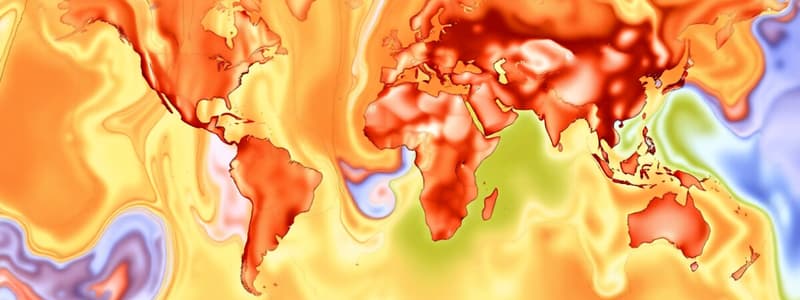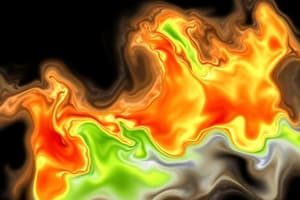Podcast
Questions and Answers
What is the primary factor that controls temperature distribution on Earth?
What is the primary factor that controls temperature distribution on Earth?
- Ocean currents
- Wind patterns
- Altitude
- Latitude (correct)
Which of the following is true regarding the diurnal temperature pattern?
Which of the following is true regarding the diurnal temperature pattern?
- The sun reaches its highest angle at midnight.
- Net positive radiation occurs after sunset.
- Temperature reaches its peak during the day, with net positive radiation. (correct)
- Net negative radiation is experienced during the day.
During which day of the year will the Northern Hemisphere experience the highest net radiation?
During which day of the year will the Northern Hemisphere experience the highest net radiation?
- Spring equinox
- Summer solstice (correct)
- Fall equinox
- Winter solstice
Which of the following is the most important "storage" of energy on Earth?
Which of the following is the most important "storage" of energy on Earth?
Which of the following is NOT a way energy is transferred on Earth?
Which of the following is NOT a way energy is transferred on Earth?
Which of the following factors does NOT directly affect temperature?
Which of the following factors does NOT directly affect temperature?
What is the primary factor that influences temperature distribution in coastal areas?
What is the primary factor that influences temperature distribution in coastal areas?
Which of the following will experience the greatest seasonal temperature variation?
Which of the following will experience the greatest seasonal temperature variation?
What is a consequence of rising global temperatures related to polar regions?
What is a consequence of rising global temperatures related to polar regions?
What primarily determines the amount of solar energy received at various latitudes?
What primarily determines the amount of solar energy received at various latitudes?
Which phenomenon leads to the warming of the atmosphere due to trapped heat?
Which phenomenon leads to the warming of the atmosphere due to trapped heat?
What factor is associated with a decrease in precipitation in warm air interactions?
What factor is associated with a decrease in precipitation in warm air interactions?
What explains the deflection of moving objects due to the Earth's rotation?
What explains the deflection of moving objects due to the Earth's rotation?
Which of the following conditions is most likely to lead to an El Niño event?
Which of the following conditions is most likely to lead to an El Niño event?
Which of the following is the primary method by which energy is transferred from the Earth's surface to the atmosphere?
Which of the following is the primary method by which energy is transferred from the Earth's surface to the atmosphere?
Which of the following locations would receive a 90˚ noon sun angle (NSA)?
Which of the following locations would receive a 90˚ noon sun angle (NSA)?
Which of the following types of radiation has the shortest wavelength?
Which of the following types of radiation has the shortest wavelength?
Which process best explains how clouds form?
Which process best explains how clouds form?
Which of the following is an example of adiabatic cooling?
Which of the following is an example of adiabatic cooling?
What is the main source of energy for Earth's weather systems?
What is the main source of energy for Earth's weather systems?
Which type of fog is most commonly found in coastal California?
Which type of fog is most commonly found in coastal California?
Which air mass typically brings cold, dry weather to North America?
Which air mass typically brings cold, dry weather to North America?
Which of the following best describes the formation of a warm front?
Which of the following best describes the formation of a warm front?
What is the main difference between a cold front and a warm front?
What is the main difference between a cold front and a warm front?
How do tornadoes typically form?
How do tornadoes typically form?
What defines a "midlatitude cyclone"?
What defines a "midlatitude cyclone"?
What is the Coriolis effect responsible for?
What is the Coriolis effect responsible for?
Which of the following defines the jet stream?
Which of the following defines the jet stream?
Which type of air mass is associated with hot, dry conditions?
Which type of air mass is associated with hot, dry conditions?
Which type of cloud is associated with thunderstorms?
Which type of cloud is associated with thunderstorms?
What does the term "cyclogenesis" refer to?
What does the term "cyclogenesis" refer to?
How does El Niño impact weather patterns in the Pacific Ocean?
How does El Niño impact weather patterns in the Pacific Ocean?
Which of the following does the greenhouse effect cause?
Which of the following does the greenhouse effect cause?
What is the Köppen classification system used to describe?
What is the Köppen classification system used to describe?
Which of the following is most likely to experience a Mediterranean climate?
Which of the following is most likely to experience a Mediterranean climate?
Which latitudes experience the most direct sunlight throughout the year?
Which latitudes experience the most direct sunlight throughout the year?
Which of the following is a characteristic of the Arctic climate zone?
Which of the following is a characteristic of the Arctic climate zone?
What time zone is used as the standard for timekeeping worldwide?
What time zone is used as the standard for timekeeping worldwide?
What is the main cause of seasonal variations in temperature across the Earth?
What is the main cause of seasonal variations in temperature across the Earth?
Which of the following is the most direct effect of global warming?
Which of the following is the most direct effect of global warming?
Flashcards
Melting of polar ice caps
Melting of polar ice caps
The reduction of ice in polar regions due to rising temperatures.
Cumulonimbus
Cumulonimbus
A type of cloud associated with thunderstorms and heavy rainfall.
Climate regions
Climate regions
Areas categorized by specific temperature and precipitation patterns.
Trade winds
Trade winds
Signup and view all the flashcards
Temperature inversion
Temperature inversion
Signup and view all the flashcards
Temperature Distribution Control
Temperature Distribution Control
Signup and view all the flashcards
Diurnal Temperature Pattern
Diurnal Temperature Pattern
Signup and view all the flashcards
Northern Hemisphere Radiation
Northern Hemisphere Radiation
Signup and view all the flashcards
Energy Storage on Earth
Energy Storage on Earth
Signup and view all the flashcards
Ways Energy is Transferred
Ways Energy is Transferred
Signup and view all the flashcards
Temperature in Coastal Areas
Temperature in Coastal Areas
Signup and view all the flashcards
Seasonal Temperature Variation
Seasonal Temperature Variation
Signup and view all the flashcards
Greenhouse Gases
Greenhouse Gases
Signup and view all the flashcards
El Niño
El Niño
Signup and view all the flashcards
Energy transfer methods
Energy transfer methods
Signup and view all the flashcards
90° noon sun angle (NSA) location
90° noon sun angle (NSA) location
Signup and view all the flashcards
Shortest wavelength radiation
Shortest wavelength radiation
Signup and view all the flashcards
Cloud formation process
Cloud formation process
Signup and view all the flashcards
Adiabatic cooling
Adiabatic cooling
Signup and view all the flashcards
Main energy source for weather
Main energy source for weather
Signup and view all the flashcards
Coastal fog type in California
Coastal fog type in California
Signup and view all the flashcards
Cold, dry air mass
Cold, dry air mass
Signup and view all the flashcards
Warm front formation
Warm front formation
Signup and view all the flashcards
Cold front vs. warm front
Cold front vs. warm front
Signup and view all the flashcards
Tornado formation
Tornado formation
Signup and view all the flashcards
Coriolis effect
Coriolis effect
Signup and view all the flashcards
Jet stream
Jet stream
Signup and view all the flashcards
Köppen climate classification
Köppen climate classification
Signup and view all the flashcards
Study Notes
Earth's Temperature Distribution
- Primary Control: Latitude is the primary factor controlling temperature distribution on Earth.
- Diurnal Temperature Pattern: Temperature peaks during the day due to net positive radiation. The sun's highest angle occurs during midday.
- Highest Net Radiation (Northern Hemisphere): The Northern Hemisphere experiences the highest net radiation during the summer solstice.
- Primary Energy Storage: Oceans are Earth's most significant energy storage component.
- Energy Transfer Methods: Energy is transferred via convection, radiation, and evaporation. Reflection is NOT a method of energy transfer.
- Factors Affecting Temperature (Indirectly): Global winds, ocean currents, latitude, and altitude affect temperature distribution.
Coastal vs. Inland Temperatures
- Coastal Temperatures: Ocean currents strongly influence temperature in coastal areas.
- Seasonal Variations: Inland locations experience the greatest seasonal temperature variations compared to coastal regions.
Temperature Variations and Maps
- Isothermal Maps: January and July isothermal maps demonstrate significant temperature differences between the Northern and Southern Hemispheres, with higher temperatures in the Northern Hemisphere in July.
- Santa Ana Winds: The Santa Ana winds in California are caused by air sinking and warming over the Great Basin.
Atmospheric Gases and the Greenhouse Effect
- Greenhouse Gases: Water vapor and carbon dioxide are the most abundant greenhouse gases in Earth's atmosphere.
- Lowest Net Radiation: The lowest net radiation in the Northern Hemisphere occurs during the winter solstice.
- El Niño: El Niño is characterized by warm waters in the Eastern Pacific and weakened trade winds.
Energy Transfer and Processes
- Energy Transfer from Earth's Surface: Radiation is the primary method of energy transfer from Earth's surface to the atmosphere.
- Noon Sun Angle (NSA): The Equator experiences a 90° noon sun angle on the Spring Equinox.
- Short Wavelength Radiation: Ultraviolet radiation has the shortest wavelength among the listed options.
- Cloud Formation: Condensation is the primary process for cloud formation.
- Adiabatic Cooling: Air rising and expanding cools adiabatically.
- Weather Energy Source: The sun is the main energy source for Earth's weather systems.
Fog, Air Masses, and Fronts
- Coastal Fog: Advection fog is common in coastal California.
- Cold Air Masses: Continental polar (cP) air masses bring cold, dry weather to North America.
- Warm Fronts: A warm front occurs when warm air lifts cold air gradually, leading to lighter precipitation.
- Cold Fronts: Cold fronts cause sudden weather changes due to their rapid movement.
- Tornado Formation: Tornadoes primarily form when warm, moist air meets cold, dry air, creating unstable conditions.
Weather Systems and Phenomena
- Midlatitude Cyclones: Midlatitude cyclones are low-pressure systems with rotating winds that form at mid-latitudes.
- Coriolis Effect: The Coriolis effect results in the deflection of moving objects due to Earth's rotation, affecting wind direction and ocean currents.
- Jet Stream: The jet stream is a narrow band of fast-moving air high in the atmosphere.
- Air Masses (Hot/Dry): Continental tropical (cT) air masses are associated with hot, dry conditions.
- Thunderstorm Clouds: Cumulonimbus clouds are associated with thunderstorms.
- Cyclogenesis: Cyclogenesis refers to the development of a mid-latitude cyclone.
- El Niño Impact: El Niño results in warmer Eastern Pacific water temperatures and weakening trade winds.
- Greenhouse Effect Outcome: The greenhouse effect causes a warming of the atmosphere due to heat trapping.
Climate and Geography
- Köppen Classification: The Köppen classification system is used to describe climate regions based on temperature and precipitation.
- Mediterranean Climate: Coastal California is most likely to experience a Mediterranean climate.
- Most Direct Sunlight: The equator receives the most direct sunlight throughout the year.
- Isotherm: An isotherm connects areas with the same temperature on a map.
- Arctic Climate: Arctic climates are characterized by long, harsh winters with short, cool summers.
- Standard Time: Greenwich Mean Time (GMT) is the standard for timekeeping worldwide.
Earth's Seasonal variations
- Seasonal Temperature Variation: The tilt of the Earth's axis is the primary cause of seasonal variations in temperature across the planet.
- Global Warming Direct Effect: Melting of polar ice caps is a direct effect of global warming.
Studying That Suits You
Use AI to generate personalized quizzes and flashcards to suit your learning preferences.




